
Goodfood Meal Kit Review
Goodfood is one of the many meal kit companies available. But what makes this company unique is that it’s entirely Canadian. That fact alone piqued my interest. And after browsing their weekly menu on the website, I decided to give Goodfood a try. After using Goodfood for one week, I have some positives and negatives for this company. Hopefully this article will help you decide whether ordering meal kits from Goodfood is worth it.
Pros and cons
Pros | Cons |
Deliscious meals | Not available in Newfoundland-Labrador |
Diverse menu (e.g., low-carb and one-pot meals) | No options for vegan or gluten-free diets |
Well designed packaging | Plans can be expensive for some people |
New member discounts | Some meals cost an additional $1.00-$3.00 |
Referral program | |
Informative and helpful recipe cards | |
Flexible subscription service | |
Bonus items available (e.g., groceries, prepared meals) | |
Updating account/weekly order easy |
Overview
Like most meal kit companies, Goodfood has a flexible subscription. Meals can be selected four weeks in advance, and users can skip a week free of charge. Changes must be made before the cut off period, which is indicated on the weekly tab at the top of the selection page. For orders scheduled for Sundays, Mondays, Tuesdays, and Wednesdays, the cut off date is the preceding Wednesday at 11:59 pm (EST). The cut off date for the rest of the week is the preceding Saturday at 11:59 pm (EST).
Note: Goodfood is not recommended for people with extreme food allergies. Goodfood cannot guarantee that cross contamination does not take place when kits are packaged. Goodfood lists potential allergens for their recipes. You can replace those ingredients with ones from your kitchen.
Price and availability
Goodfood offers three plans: the easy prep, classic, or family baskets. The lowest price available is $9.99 per serving for four recipes for the family basket. The highest price is $14.74 per serving for three recipes for two people for the easy prep basket. The total price will depend on which plan you pick, how many recipes you order, and how many servings you select. Some recipes also cost about $2.00-$17.00 more, which has a huge impact on the weekly total cost. There is $0.00 delivery fee. A $1.99 additional fee is charged for deliveries to rural areas. If an additional box is needed to ship frozen products, a frozen box fee is charged to your order. The fee is waived if the dollar value of the frozen products exceeds $30.00.
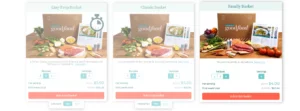
The Goodfood plans. Source: Goodfood
I picked the classic basket with three recipes for two people. The cost per serving was $13.99, with a total cost of $83.94 per week. I thought this price was quite expensive. Compared to my Chefs Plate subscription (three recipes for two people), Goodfood costs $24.00 more. Luckily, Goodfood has discounts for new users. On my first order, $69.95 was taken off the weekly total; I ended up paying only $13.99. I could also receive five free meals in each of my first two baskets. Full-time members also have access to exclusive discounts and offers. Goodfood has a referral link that lets you earn Goodfood credits. Send $40.00 worth of credits to a friend for free through a personal referral link. For each new Goodfood member, you will receive a $25.00 credit. You can use the credits to pay for your weekly orders.
Goodfood is available in every province except Newfoundland and Labrador. Once you add your address during sign up, Goodfood will notify you if they cannot deliver to your area. If you want to check if you fall within Goodfood’s delivery range, contact their customer support team at [email protected].
Ordering meals and dietary variety
As I mentioned earlier, users can select their meals four weeks in advance. Goodfood will automatically select your meals based on the preferences you set during sign up (e.g., what foods do you like to eat, do you like spicy food etc.). Adding and dropping recipes is simple. Click the plus (+) symbol to add a recipe or increase the number of servings. Click the minus (-) symbol to reduce the number of servings or to remove a recipe. Most of the recipes have symbols located at the top left hand of their picture. The symbols can indicate the cooking time, meal type, and how much cookware is needed. For example, the symbols for the Mild Yellow Coconut Cod Curry say it’s a carb-wise dish and takes 20 minutes to make.
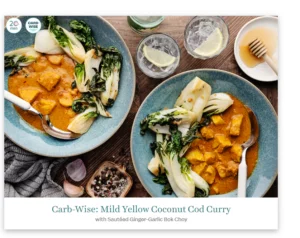
Source: Goodfood
Bonus items can be added to your weekly delivery. Goodfood has prepared meals like butter chicken or cheddar & onion quiche. Grocery items like chips, dairy, meat, and spice blends are also available.
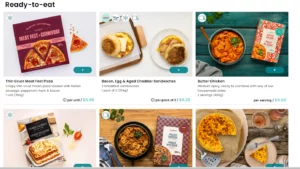
Source: Goodfood
If you want to skip a week, click the “Skip week” button at the top right-hand corner of the screen. If you change your mind, click on the button again. I liked how simple this process was. Instead of going through a complex system, I just had to make one click.
I found Goodfood’s weekly menus to be very diverse. I liked that I had so many recipe options. It kept things fresh and interesting. Each weekly menu featured unique and appetizing recipes. Low carb (called Clean15), one pot, and spicy recipes are available, as well as higher end dishes labelled as L’Artisan. These meals use premium ingredients like lobster, filet mignon, and tiger shrimp. I did not order these dishes as they were pretty expensive. But they would be great for home chefs and for people who enjoy fancy meals. Another interesting group of Goodfood dishes are the dinner + lunch combos. Some of the leftover ingredients from the dinner recipe are used in a separate lunch meal.
Unfortunately, there are no vegan or gluten-free recipes. This wasn’t an issue for me since I do not follow those diets. But this is an obvious problem for people who do follow them. There are no customizable meals as well. Being able to swap ingredients would have been a nice feature to have.
Packaging and recipe cards
For my Goodfood order, I selected the:
- Speedy shrimp fajitas
- Fast ground beef-stuffed pitas with sumac cuke salad
- Pork sausage, potato & carrot traybake
My order came in a cardboard box with each recipe stored in plastic bags. Underneath the recipe bags were the protein ingredients: the pork sausages, ground beef, and shrimp. The recipe cards were placed at the very top of the box. To keep the contents fresh, large ice packs were placed at the bottom of the box. Insulation material along the inside of the box helped keep the package cool.
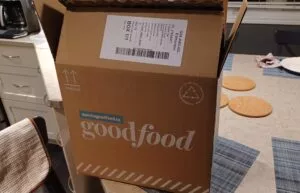
Source: Rank-It.ca

Source: Rank-It.ca

Source: Rank-It.ca
I thought Goodfood did a good job with their packaging. Compared to Chefs Plate, there was hardly any excess bags or pouches to deal with. The recipes and their ingredients all came in the same box. There wasn’t an extra bag holding the frozen ingredients. The contents inside the box were neatly arranged. These factors made it very easy to unpack. I liked that the plastic recipe bags were see through. You can check to see if anything is missing. Plus, I could easily store the bags in my fridge. The box’s insulation material was another positive for the packaging. I received my order at 10:22 am, and I unpacked everything at 7:00 pm. During that interval, every ingredient remained fresh thanks to the insulation. The meat may have thawed slightly, but by no means did it spoil. Goodfood claims that their boxes stay fresh for 24 to 48 hours during delivery, and I believe it.

Source: Rank-It.ca
The recipe cards were informative and easy to understand. I had no problems with following the instructions; they were not complicated or confusing. The pictures for each step were helpful visual aids. I looked at them often to ensure I was doing things correctly. The cards did not include any cooking tips or tricks. The only advice was the recommended internal temperature for cooked meats and seafood. However, I picked fairly simple dishes, so there wasn’t really any need for cooking tips.
The physical recipe cards only list the calories per serving. The full nutritional list is printed on a sticker which is attached to the recipe bag. The entire list is also on the recipe’s webpage; however, it is not as detailed. The physical version includes the corresponding serving size, and it also lists the trans fast amount (which the digital version does not list).
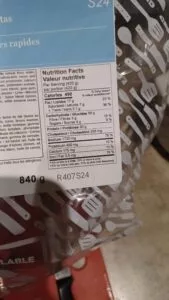
Nutritional values printed on the recipe bag. Source: Rank-It.ca

Nutritional facts listed on the Goodfood website. Source: Goodfood
Both versions of the nutritional list were identical to each other. The physical version did not base the information on a different serving size. The same serving sizes were used; therefore, their numbers were the same. This uniformity was appreciated after my experience with Chefs Plate’s nutritional lists. At no point did I question which version had the correct information.
Meal #1
Speedy shrimp fajitas
Nutritional values: per serving
- Calories: 490kcal
- Total fat: 17g
- Saturated fat: 7g
- Total carbs: 56g
- Sugars: 9g
- Fibre 5g
- Protein: 30g
- Sodium: 1720 mg
Listed cook time: 10 minutes. Skill level: easy.
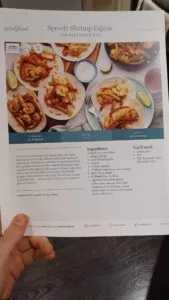
Source: Rank-It.ca
Even though this recipe is supposed to take 10 minutes, it took me about 22 minutes. The reason it took longer is because I like to take my time when cooking a new recipe. Each time I make the recipe, my cook time improves. Despite the longer cook time, this recipe was easy to make. I didn’t have to use any fancy techniques when frying the shrimp and vegetables. To warm the tortillas, all I had to do was wrap them in aluminum foil and bake them on an oven rack for six minutes. Food prep was minimal. I only had to slice the poblano and sweet pepper, dice the lime into wedges, and remove the shrimp tails from the shell. This recipe only used one frying pan, which made the clean up easier.
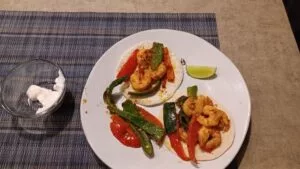
Source: Rank-It.ca
I really liked the flavour of the speedy shrimp fajitas. The America Latina spice mix had a savory and smoky taste. It enhanced the flavour of the shrimp and peppers. The lime juice had the right amount of sweetness, which blended well with the saltiness of the spice blend. The sour cream, with its creamy texture, was the perfect condiment for this recipe. I’m not the biggest fan of sour cream, but it blended nicely with the sweet and salty flavours. I am a fan of shrimp, and the ones used in the recipe were plump and tender. The poblano pepper gave the recipe a spicy kick (if you want to turn up the heat, add the pepper’s seeds to the dish). This spiciness was counterbalanced well by the sweet red pepper.
I did not have many negatives for the speedy shrimp fajitas. The only surprise was the size of the tortillas. I expected them to be larger than they actually were. Because they were small, I had some difficulty with wrapping the contents. There were a few times when a piece of shrimp or pepper would fall out of the tortilla wrap as I ate. But this drawback did not take away from my enjoyment of the Speedy Shrimp Fajitas.
Meal #2
Fast ground beef-stuffed pitas with sumac cuke salad
Nutritional values: per serving
- Calories: 780kcal
- Total fat: 40g
- Saturated fat: 9g
- Total carbs: 70g
- Sugars: 10g
- Fiber: 15g
- Protein: 42g
- Sodium: 1240mg
Listed cook time: 10 minutes. Skill level: easy.
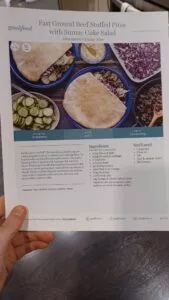
Source: Rank-It.ca
The beef stuffed pitas was another easy recipe to make. The beef was cooked in six minutes, while the cucumber salad and slaw took less than five minutes to make. The hummus was already prepared, and all I had to do was add some of the spice mix to it. The instructions say to heat the pitas in the microwave for 30 seconds. I decided to bake them in the oven instead; I wanted the pitas to have a crispy quality. Even though the pitas were crispy and crunchy, I should have followed the recipes instructions. Baking the pitas in the oven made them more brittle and less pliable.
The hardest part of this recipes was making the pitas into a pocket sandwich. According to the instructions, you cut off ¼ from the top of the pita to create the pocket area. However, the pitas were very thin, which made it hard to cut them. Whenever I tired cutting the top of the pita, I ended up tearing the bread. I was also a little unsure on how to cut the pita correctly. The instruction was vague; it did not describe the task in detail. Plus, the recipe card did not have any photos demonstrating the process. Having some example pictures would have made the task easier. After failing multiple times, I placed the beef, coleslaw, cucumbers, and hummus on top of the pita instead.
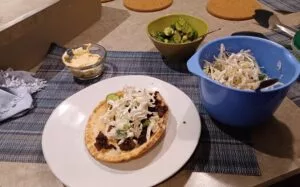
Source: Rank-It.ca
I still enjoyed the taste of the beef stuffed pitas. The highlights of this dish were the slaw and the cucumber salad. Both had a tangy flavour that blended well with the olive oil (for the cuke salad) and the mayo (for the slaw). I am not too familiar with hummus, but I enjoyed it in this dish. It was smooth with just the right amount of thickness. Adding it to the pita wrap really enhanced the flavor. The beef was good, but I thought it was a little too greasy. I had to drain the excess grease from the pan. The spice blend was so-so. I couldn’t really taste it in the cuke salad, but it was more noticeable in the hummus and beef. The blend had a sweet and savoury flavour that worked well in the recipe. To increase the spice level, I added some chili flakes from my pantry.
The Beef Stuffed Pitas was another one-pot meal, meaning clean up was minimal. When I make this recipe again, I’ll try to cut the pitas properly. Eating it as a stuffed pita might improve the quality of this dish.
Meal #3
Pork sausage, potato, & carrot traybake
Nutritional values: per serving
- Calories: 730kcal
- Total fat: 39g
- Saturated fat: 11g
- Total carbs: 64g
- Sugars: 14g
- Fibre: 10g
- Protein: 33g
- Sodium: 2380mg
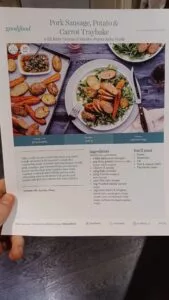
Source: Rank-It.ca
The last meal for my weekly order was the pork sausage, potato & carrot traybake. This recipe took the longest to make; it took me about 46 minutes. The reason for this longer cook time was my oven. The instructions said to preheat the oven to 450˚F. It took my oven about 5-6 minutes to reach that temperature, which added to the overall cook time. Other than that, the recipe was simple. After prepping the sausage, carrots, and potatoes, all I had to do was place them on a baking pan and roast them for 25-30 minutes. Once that was finished, I had to broil the ingredients for 2-3 minutes. The salsa verde and salad were also easy to make; it took no more than five minutes.
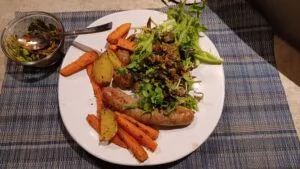
Source: Rank-It.ca
The salad and salsa verde were the two things that stood out for me. The vinegar gave both a tangy flavour. The parsley in the salsa verde added a bright and peppery taste, while the roasted pepitas provided a nice crunch. The sausage, potatoes, and carrots were delicious. The carrots and potatoes browned nicely. Both had a crisp outer layer and were soft to bite. The sausage was tender and juicy and had a slightly sweet flavour. The spice blend for this recipe was a mixed bag. I barley tasted it on the carrots and potatoes. I added some Montreal chicken spice to enhance that taste. However, I did taste the spice in the salsa verde. The mix had a buttery and zesty flavour, which complimented the parsley. One negative I had with this recipe is that the potatoes did not heat evenly. Some were roasted to perfection, while others were still a little too firm. This was most evident in the larger pieces. With that being said, I might have not baked them long enough. Still, I think the instructions should recommend you slice the potatoes into smaller pieces so that they cook properly.
The pork sausage, potato, & carrot traybake was my favourite recipe of the bunch. Even though it took longer to make, it won me over with its simplicity. This meal was also very filling, which left me happy at the end of the night.
Final verdict
After using Goodfood for a week, I have several positives. The meals were delicious and easy to make. The menu was diverse, with low-carb, artisan, and one pot recipe available each week. The additional food items were a nice bonus. When I needed to update my account, I could do so with a few simple clicks. The packaging was well designed and it was easy to store and recycle the material.
However, there are two concerns I have with Goodfood. The first is their prices. While Goodfood’s plans aren’t outrageously expensive, they might not be affordable for some people. Some recipes cost an additional $1.00-$3.00, which I didn’t notice at first. Ordering these higher priced meals increases the cost for your weekly order. This can have a huge impact for someone living on a tight budget. I would like to see Goodfood have universal prices for their recipes that match your plan (e.g., every meal cost $13.74). The second concern I have is with the menu options. Even though Goodfood offers low-carb recipes, there are no gluten-free or vegan-friendly dishes. Adding those recipes to the weekly menus would increase Goodfood’s customer base.
But in the end, I still enjoyed my experience with Goodfood. While the prices were somewhat high, I felt the quality of the meals justified the cost. Plus, the $0 delivery fee and new member discounts help keep costs reasonable. I’d recommend people try Goodfood for one week to take advantage of the discounts. After this trial period finishes, you can decide whether you want to continue your subscription. At the moment, Goodfood is a little too expensive for me. However, I’d renew my subscription if I could split the cost with one or two friends.
Specs
Pricing |
|
Delivery range |
|
Dietary variety |
|
Other features |
|
Read more

Best Stand Mixers in Canada
Level up your baking with a stand mixer.
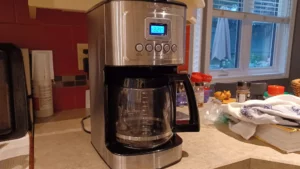
Cuisinart DCC 3200 Coffee Maker Review
If you love coffee, the Cuisinart DCC 3200 is a product you will enjoy.

How to Shop for Honey + Best Brands in Canada
This guide will help you find the best honey brands in Canada.
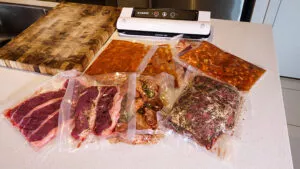
The Best Vacuum Sealers in Canada
Whether cutting your food waste, or upping your food game, these vacuum sealers can help!